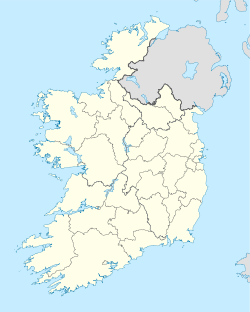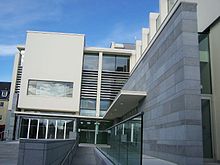- Galway
-
This article is about the city of Galway in Ireland. For other uses of the name, see Galway (disambiguation).
Galway
GaillimhThe Tribes of Galway, Eyre Square
Flag
Coat of armsNickname(s): City of the Tribes Motto: Laudatio Ejus Manet In Secula Seculorum[1] (Latin)
"His Praise Remains unto Ages of Ages"Galway City in Ireland Coordinates: 53°16′19″N 9°2′56″W / 53.27194°N 9.04889°WCoordinates: 53°16′19″N 9°2′56″W / 53.27194°N 9.04889°W Country Ireland Province Connacht County Galway Government - Type City Council - Mayor of Galway Hildegarde Naughton[2] - LEAs 3 - Dáil Éireann Galway West - European Parliament North-West Population (2011) - City 75,414 - Urban 75,414 - Demonym Galwegian, Tribesman Time zone WET (UTC0) - Summer (DST) IST (UTC+1) Area code(s) 091 Car plates G Website www.galwaycity.ie Galway (Irish: Gaillimh, pronounced [ˈɡalʲɪvʲ]) or City of Galway (Cathair na Gaillimhe) is a city in County Galway, Republic of Ireland. It is the fifth largest[3][clarification needed] and the fastest-growing[citation needed] city in Ireland. It is also the third largest city within the Republic and the only city in the Province of Connacht. Located on the west coast of Ireland, it sits on the River Corrib between Lough Corrib and Galway Bay. The population of Galway's Borough area is 75,414 according to the 2011 census.
Contents
Etymology
The city takes its name from the Gaillimh river (River Corrib) that formed the western boundary of the earliest settlement, which was called Dún Bhun na Gaillimhe ("fort at the mouth of the Gaillimh").[4] The word Gaillimh means "stony" as in "stony river" (the mythical and alternative derivations are given in History of Galway). Historically, the name was written as Gallive,[5] which is closer to the Irish pronunciation.
The city also bears the nickname City of the Tribes / Cathair na dTreabh because "fourteen tribes" (merchant families)[6] led the city in its Hiberno-Norman period. The term tribes was often a derogatory phrase in Cromwellian times. The merchants would have seen themselves as Irish gentry, but were loyal to the King. They subsequently adopted the term in defiance to the Cromwellian occupiers of the town.
History
Main article: History of Galway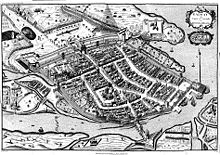 The walled city in 1651 (North is to the left). The River Corrib is in the foreground, crossed by what is now "O’Briens Bridge", leading to Mainguard Street.
The walled city in 1651 (North is to the left). The River Corrib is in the foreground, crossed by what is now "O’Briens Bridge", leading to Mainguard Street.
Dún Bhun na Gaillimhe ("Fort at the Mouth (bottom) of the Gaillimh") was constructed in 1124, by the King of Connacht, Tairrdelbach Ua Conchobair (1088–1156). A small settlement eventually grew up around this fort. During the Norman invasion of Connacht in the 1230s, Galway fort was captured by Richard Mor de Burgh, who had led the invasion. As the de Burghs eventually became gaelicised, the merchants of the town, the Tribes of Galway, pushed for greater control over the walled city.
Historical populations Year Pop. ±% 1813 24,684 — 1821 27,775 +12.5% 1831 33,120 +19.2% 1841 17,275 −47.8% 1851 20,055 +16.1% 1861 16,048 −20.0% 1871 15,597 −2.8% 1881 15,471 −0.8% 1891 13,800 −10.8% 1901 13,426 −2.7% 1911 13,255 −1.3% 1926 14,227 +7.3% 1936 18,294 +28.6% 1946 20,370 +11.3% 1951 21,316 +4.6% 1956 21,366 +0.2% 1961 23,700 +10.9% 1966 26,295 +10.9% 1971 29,375 +11.7% 1981 41,861 +42.5% 1986 47,104 +12.5% 1991 50,853 +8.0% 1996 57,363 +12.8% 2002 66,163 +15.3% 2006 72,729 +9.9% 2011 75,414 +3.7% [7] This led to their gaining complete control over the city and to the granting of mayoral status by the English crown in December 1484. Galway endured difficult relations with its Irish neighbours. A notice over the west gate of the city, completed in 1562 by Mayor Thomas Óge Martyn, stated "From the Ferocious O'Flahertys may God protect us". A by-law forbade the native Irish (as opposed to Galway's Hiberno-Norman citizens) unrestricted access into Galway, saying "neither O’ nor Mac shall strutte nor swagger through the streets of Galway" without permission. During the Middle Ages, Galway was ruled by an oligarchy of fourteen[6] merchant families (12 of Norman origin and 2 of Irish origin). These were the "tribes" of Galway. The city thrived on international trade, and in the Middle Ages, it was the principal Irish port for trade with Spain and France. The most famous reminder of those days is ceann an bhalla ("the head of the wall"), now known as the Spanish Arch, constructed during the mayoralty of Wylliam Martin (1519–20). In 1477 Christopher Columbus visited Galway, possibly stopping off on a voyage to Iceland or the Faroe Islands. Seven or eight years later, he noted in the margin of his copy of Imago Mundi "Men of Cathay have come from the west. [Of this] we have seen many signs. And especially in Galway in Ireland, a man and a woman, of extraordinary appearance, have come to land on two tree trunks [or timbers? or a boat made of such?]" The most likely explanation for these bodies is that they were Inuit swept eastward by the North Atlantic Current[4]
During the 16th and 17th centuries Galway remained loyal to the English crown for the most part, even during the Gaelic resurgence, perhaps for reasons of survival. However, by 1642 the city had allied itself with the Catholic Confederation of Kilkenny during the Wars of the Three Kingdoms. During the resulting Cromwellian conquest of Ireland, Cromwellian forces captured the city after a nine-month siege. At the end of the 17th century the city supported the Jacobites in the Williamite war in Ireland and was captured by the Williamites after a very short siege not long after the Battle of Aughrim in 1691. The great families of Galway were ruined, and, having declined owing to the potato famines of 1840–1845, the city did not fully recover until the great economic bubble of the late twentieth century.
Local government
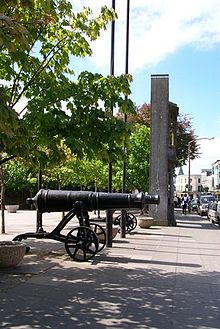 Cannon at Eyre Square, Galway The cannons were presented to the Connaught Rangers at the end of the Crimean War (1854–1856) in recognition of their military achievements. These cannons have since been moved to Galway City Hall.
Cannon at Eyre Square, Galway The cannons were presented to the Connaught Rangers at the end of the Crimean War (1854–1856) in recognition of their military achievements. These cannons have since been moved to Galway City Hall. See also: Galway City Council and Mayor of Galway
See also: Galway City Council and Mayor of GalwayServices such as waste collection, recycling, traffic control, parks and housing are controlled by a fifteen member city council elected to five year terms by proportional representation. The City Council is chaired by a mayor who is elected to a one year term by their fellow councillors. Their role is mainly ceremonial, although they do have the casting vote. The current mayor is Cllr. Hildegarde Naughton, who was elected Mayor of Galway in June 2011.
Galway City is part of the Galway West constituency of Dáil Éireann. Its TDs (parliametary representatives) are:
- Noel Grealish (Independent). A Native of Cearn Mór.
- Derek Nolan (Labour). Galway City based. He is a new TD for Galway West.
- Éamon Ó Cuív (Fianna Fáil). Corr na Móna in Conamara based. He is the former Minister for Social Protection.
- Brian Walsh (Fine Gael). Galway City based. A native of Mervue.
- Seán Kyne (Fine Gael). Based in Moycullen.
Climate
Galway experiences a year-round mild, moist, temperate and changeable climate, due to the prevailing winds of the North Atlantic Current. The city experiences a lack of temperature extremes, with temperatures below 0 °C (32 °F) and above 30 °C (86 °F) being rare. The city receives an average of 1,147 mm (45.2") of precipitation annually, which is evenly distributed throughout the year. Rain is the most common form of precipitation. Hail, sleet and snow are rare, though will sometimes be experienced during particularly cold winters. Galway is also consistently humid, with humidity normally ranging from 70% to 100%, and this can lead to heavy showers, and even thunderstorms breaking out when drier east winds, originating in the European continent, clash with this humidity, particularly in the late summer. The average January temperature in the city is 6.8 °C (44 °F) and the average July temperature is 16.0 °C (61 °F). This means that Galway, like most of Ireland, is said to have a Maritime Temperate climate (Cfb) according to the Köppen climate classification system.
While extreme weather is rare, the city and county can experience severe windstorms that are the result of vigorous Atlantic depressions that occasionally pass along the north west coast of Ireland. Most of these storms occur between late autumn and early spring. Due to the city's northerly location and its longitude, Galway has long summer days. Daylight at midsummer is before 04:00 and lasts until after 23:00. In midwinter, daylight does not start until 09.00, and is gone by 16:00. Due to its mild and moist climate, Galway supports plantlife not usually found at such high latitudes, such as palm trees and fig trees.[8]
Culture
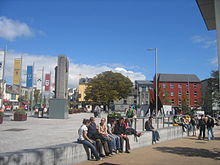 Eyre Square is at the centre of the city.
Eyre Square is at the centre of the city.
Galway is known as Ireland's Cultural Heart (Croí Cultúrtha na hÉireann)[9] and is renowned[citation needed] for its vibrant lifestyle and numerous festivals, celebrations and events. Every July, Galway hosts the Galway Arts Festival which is known for its famous Macnas parade.
In 2004, there were three dance organisations, ten festival companies, two film organisations, two Irish language organisations, 23 musical organisations, twelve theatre companies, two visual arts groups, and four writers' groups based in the city.[10]
Furthermore, there were 51 venues for events, most of which were specialised for a certain field (e.g. concert venues or visual arts galleries), though ten were described as being 'multiple event' venues.[10] The main squares in the city are Eyre Square (containing John F. Kennedy Park) in the centre of the city, and Spanish Parade next to the Spanish Arch.
In 2007, Galway was named as one of the eight "sexiest cities" in the world.[11] A 2008 poll ranked Galway as the 42nd best tourist destination in the world, or 14th in Europe and 2nd in Ireland (behind Dingle). It was ranked ahead of all European capitals except Edinburgh, and many traditional tourist destinations (such as Venice).[12]
Music
Galway has a vibrant and varied musical scene. As in most Irish cities traditional music is popular and is kept alive in pubs and by street performers. Notable bands from Galway include The Saw Doctors and The Stunning. Galway Early Music Festival presents European music from the 12th to the 18th century. It encourages not only music, but also dance and costumes. The festival involves both professional and amateur musicians.[13]
Galway Cathedral Recitals is an international series of concerts of classical music which has taken place in Galway Cathedral each July and August since 1994.[14]
The Galway Arts Festival (Féile Ealaíon na Gaillimhe) takes place in July. It was first held in 1978 and since then has grown into one of the biggest arts festivals in Ireland. It attracts international artists as well as providing a platform for local and national performers. The festival features parades, street performances and plays, musical concerts and comedy acts. Highlights of the festival tend to be performances by Macnas and Druid Theatre Company, two local performance groups.
The renowned performer and singer Siobhan McCormack currently resides in Galway with well known dancer Michael Flanagan.
Irish language
 Galway Arts Festival Parade 2007
Galway Arts Festival Parade 2007
There are 6870 Irish speakers in Galway city nearly 10% of the population. Galway city has a reputation amongst Irish cities for being associated with the Irish language, music, song and dancing traditions. It is sometimes referred to as the 'Bilingual Capital of Ireland', although like all other cities in the Republic of Ireland, the vast bulk of the city's inhabitants converse mostly in English. The city is well known for its "Irishness", mainly because it has on its doorstep the Galway Gaeltacht. Irish theatre, television and radio production and Irish music form a component of Galway city life, with both An Taibhdhearc, the National Irish Language Theatre, in Galway city itself, while TG4 and RTÉ Raidió na Gaeltachta headquarters are in the Connemara Gaeltacht elsewhere in County Galway. Four electoral divisions, or neighbourhoods (out of twenty-two), are designated as Gaeltachtaí.[10] NUI Galway also holds the archive of spoken material for the Celtic languages.[15]
Events
Many sporting, music, arts and other events take place in the city. The largest of these annual events include the Galway Arts Festival, the Galway Races, and the Galway International Oyster Festival. Other events include the Fleadh Imboilg,the Baboró International Children's Festival, the Cúirt International Festival of Literature, the Galway Early Music Festival,[16] Seachtain na Gaeilge (March), Salthill Air Show (June), Little Havana Festival, the Galway Sessions,[17] Galway Garden Festival,[18] Galway Comedy Festival, Baffle Poetry Festival, Galway Aboo Halloween Festival, Spirit of Voice Festival, Galway Christmas Market, Galway Film Fleadh,[19] Galway African Film Festival and Galway Pride Festival.[20] In 2009 Galway hosted a stopover on the Volvo Ocean Race. Galway will host the Volvo Ocean Race once again, and this time it will be for the finish of the round-the-world competition in early-summer 2012. In June 2010, the Super8 Shots film festival was launched in Galway, the first Super 8 mm film festival to occur in Ireland.[21] Among the festivals which take place within a 90 minute drive of the city are, Cruinniú na mBád (a Galway Hooker festival), held in Kinvara, the Cuckoo Festival, also held in Kinvara, the Clarinbridge Oyster Festival, Féile na nOileáin, held in Leitir Mor, Conamara, the Clifden Community Arts week and the Conamara Pony Show, held in Clifden.
Media
Broadcasting
Radio
There are two radio stations based in the city – Galway Bay FM (95.8 FM) broadcasts from the city to the whole county; Flirt FM (101.3 FM) the student radio station for NUIG.
The national radio stations – RTÉ's Radio 1, 2fm, lyric fm, Raidió na Gaeltachta and the independent stations Today FM Newstalk and iRadio – are all available in Galway, as is the multi-city service 4fm.
Television
The cable station City Channel has an opt-out for Galway available throughout the county. RTE has a studio in the city.
Print
One of the main regional newspapers for the county is The Connacht Tribune which prints three titles every week, the Connacht Sentinel on Tuesday, the Connacht Tribune on Thursday, and the Galway City Tribune on Friday. As of January 2007, The Tribune has a weekly readership of over 150,000. Another Galway-based newspaper is the Galway Advertiser,a free paper printed every Thursday with an average of 160 pages and a circulation of 70,000 copies. It is the main paper of the Advertiser Newspaper Group which distributes 200,000 newspapers per and more week to a variety of other Irish cities and towns. Another free paper, the Galway Independent, prints on a Tuesday night for Wednesday circulation.
Places of interest
Lynch's Castle on Shop Street is probably the finest medieval town house in Ireland. It is now a branch of the Allied Irish Bank.
The Church of Ireland St. Nicholas' Collegiate Church is the largest medieval church still in everyday use in Ireland. It was founded in 1320 and enlarged in the following two centuries. It is a particularly pleasant building in the heart of the old city.
Its Roman Catholic counterpart, the Cathedral of Our Lady Assumed into Heaven and St Nicholas was consecrated in 1965 and is a far larger, more imposing building constructed from limestone. It has an eclectic style, with renaissance dome, pillars and round arches, and a Romanesque portico that dominates the main façade – which is an unusual feature in modern Irish church building. It was suggested by a church in the city of Salamanca in Spain.
Not far from the cathedral stands the original quadrangle building of National University of Ireland, Galway which was erected in 1849 (during An Gorta Mór, the Great Famine) as one of the three colleges of the Queen's University of Ireland (along with Queen's University Belfast and University College Cork). The university holds the UNESCO archive of spoken material for the Celtic languages.
Another of the city's limestone buildings is the Hotel Meyrick, originally the Railway Hotel and then the Great Southern Hotel, built by the Great Southern Railway Company in 1845.[22] Sitting at the southern perimeter of Eyre Square, it is the City's oldest hotel still in operation.
The Spanish Arch in the southwest of the city, was built as an extension to the city walls, a part of which can be seen in the Corbett Court shopping centre. The remains of the Menlo castle can also be seen, outside the city.
Theatre
Galway has a permanent Irish language theatre located in the city centre, Taibhdhearc na Gaillimhe, which has produced some of Ireland's most celebrated actors. The Druid Theatre Company has won international acclaim for its cutting edge production and direction.
There are many theatres in the city including Nun's Island Theatre, The Bank of Ireland Theatre, The Druid Lane Theatre and The Town Hall Theatre, a modern art theatre with two performance spaces opened in 1995[23] that has a 52 week program covering all aspects of the performing arts including ballets, musicals and operas. It has been the venue for many Irish film premieres, during the Galway Film Fleadh.
Museum
The Galway City Museum features two parts, "Fragments of a City" and "On Reflection." "Fragments of a City"'s collection is mainly about the heritage of Galway, while "On Reflection" is a collection of the most important Irish artists from the second half of the 20th century. This museum was designed to allow tourists and local visitors to really get to understand and know the city of Galway. This museum also houses the statue of the famous poet, Pádraic Ó Conaire which was originally located in the Kennedy Park section of Eyre Square, prior to the Square's renovation.
Demographics
Based in the 2006 census, the population of Galway City and its environs is 72,729, of which 72,414 live in the city limits and 315 live in the city's environs in County Galway.[24] If the current growth rate continues, the population of the city will hit 100,000 by 2020.[25] Galway City (population inside the city limits) is the third largest in the Republic of Ireland, and fifth on the island of Ireland. However, the population of the wider urban area, is fourth largest in the Republic of Ireland (sixth on the island).
Approximately 78% of the population of Galway is white Irish, descended from native Gaelic peoples and Norman settlers. A further 5% are foreign-born Irish.[26] Following an influx of immigrants to Galway during the 2000s, approximately 17% of the population is non-Irish.[26] Slightly more than half of this group are white Europeans, coming from Poland and other Central European and Baltic States, such as Latvia and Lithuania. Smaller numbers of Asian and African immigrants come from East Africa, Nigeria, Zimbabwe and Sri Lanka. In the 2006 Census, 15.4% of the population were aged 0–14, 76.1% were aged 15–64, and 8.5% were aged over 65. 51.9% of the population were female and 48.1% were male.[27]
Economy
Galway City is the capital of Connacht, and the third largest city in the Republic of Ireland after Dublin and Cork. The city has experienced very rapid growth in recent years. Galway has a strong local economy with complementary business sectors, including manufacturing industry, tourism, retail and distribution, education, healthcare and services that include financial, construction, cultural, and professional.
Most (47%) of the people employed in Galway work in either the commerce or professional sector, with a large number (17%) also employed in manufacturing. Most industry and manufacturing in Galway, like the rest of Ireland, is hi-tech (e.g. ICT, medical equipment, electronics, chemicals, etc.), due to the Celtic Tiger economic boom. Tourism is also of major importance to the city, which had over 2.1 million visitors in 2000, and produced revenue of over €400 million.[28]
Transport
Air
Galway Airport, located 6 km (3.73 mi) east of the city at Carnmore, has scheduled services connecting Galway to Waterford in Ireland; Edinburgh, London and Manchester in Britain; and a seasonal connection to Lorient in France. Because the runway is too short to take modern passenger jet aircraft, its operations are limited.[29] Airline that serve the airport is Aer Arann. Aerfort na Minna (22 km (13.67 mi) west of the city) operates regular flights to each of the Aran Islands (Oileáin Árann). Shannon Airport (90 km) and Ireland West Airport Knock (86 km) are also within easy reach of the city, both of which have flights around Ireland and to Britain, Continental Europe and North America (from Shannon).
Bus
Buses are the main form of public transport in the city and county. There are fifteen routes[30] in the city operated by Bus Éireann and Galway City Direct.
Various bus companies also provide links throughout County Galway and nationwide.[31] These operate from a number of locations:
- The main bus and rail station in the city is Ceannt Station.
- Galway Coach Station, located at Fairgreen,[32] is also a coach transport hub. Scheduled direct and commuter services operate between the Coach Station, Dublin and Dublin Airport, as well as services to Limerick, Cork and Clifden. These are operated by Gobus and Citylink.[33][34]
- Other regional bus operators user various bus stops around the city centre, and many serve the NUIG and GMIT campuses as well.
Rail
Galway's main railway station is Ceannt Station (Stáisiún Cheannt), which opened in 1851,[35] and was renamed in honour of Éamonn Ceannt in 1966. A major redevelopment, including a completely new urban district, Ceannt Station Quarter,[36][37] has been proposed for the station and adjoining land.
The Midland Great Western Railway reached Galway in 1851, giving the city a direct main line to its Broadstone Station terminus in Dublin. As the 19th century progressed the rail network in Connacht was expanded, making Galway an important railhead. The nearby town of Athenry became a railway junction, giving Galway links to Ennis, Limerick and the south in 1869 and Sligo and the north in 1894. In 1895 the MGW opened a branch line between Galway and Clifden.
The 20th century brought increasing road competition, and this led the Great Southern Railways to close the Clifden branch in 1935. In the 1970s the state railway authority Córas Iompair Éireann closed the Sligo-Athenry-Ennis line to passenger services. It later closed to freight as well.
Iarnród Éireann, Ireland's national rail operator, currently runs six return passenger services each day between Galway and Dublin Heuston, also serving intermediate stations. Travel time is just under 3 hours. Services on the Galway–Limerick line have now resumed, with around 5–6 trains each way per day.
Road
Three national primary roads serve the city: the N17 leading North (Tuam, Sligo, Donegal Town, Letterkenny and Derry), the M6 motorway from the East (Athlone, Dublin), and the N18 from the South (Shannon Town, Limerick and Cork). By 2015, the Galway-Dublin, Galway-Limerick and Galway-Tuam routes will be motorway or high-quality dual carriageway standard. In addition, there are plans for a semi-ring road of the city, the Galway City Outer Bypass, which should also be complete by 2015.[38][39] There is also an Inner City Ring (Cuar Inmheánach) route that encircles the city centre, most of which is pedestrianised.
Galway is considered the gateway to Connemara and the Gaeltacht, including Mám, An Teach Dóite, Cor na Móna, Ros Muc, Bearna and An Cheathrú Rua. The N59 along the western shore of Lough Corrib and the R337 along the northern shore of Galway Bay both lead to this largely rural and highly scenic region.
Waterway
The River Corrib is by far the most important waterway in Galway and a number of canals and channels were built above and through the city. The purposes of these to divert and control the water from the river, to harness its power and to provide a navigable route to the sea.[40] Of these, there were two major schemes – one between 1848 and 1858 and the other during the 1950s. The canals provided a power source for Galway and were the location of the first industries in the mid-19th century. The Eglinton Canal provided a navigation from the sea (at the Claddagh Basin) to the navigable part of the river (above the Salmon Weir Bridge). Most of the mills are still used today for various purposes; for instance, NUI Galway still uses a water turbine for electricity generation for their building on Nun's Island.
Currently, there are four bridges across the Corrib: the William O'Brien Bridge, the Salmon Weir Bridge, the Wolfe Tone Bridge and the Quincentennial Bridge. There are plans for a fifth bridge as part of the Galway City Outer Bypass project. The Clare River flows from the North of the County Galway, through Tuam, Claregalway into Lough Corrib.
Harbour
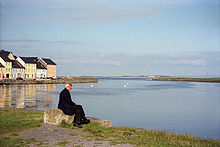 Ballyknow Quay, Claddagh
Ballyknow Quay, Claddagh
Galway is the most central port on the West Coast of Ireland in the sheltered eastern corner of Galway Bay.[citation needed] The harbour can be used by vessels up to 10,000 metric tons deadweight (DWT) and the inner dock can accommodate up to 9 vessels at any one time. Pending approval, Galway Harbour may see major changes, should the €1.5 billion development plan go ahead.
Regular passenger ferry and freight services operate between Galway and the Aran Islands. The islands also have regular links with the towns of Rossaveal and Doolin, which are physically closer but far smaller.
Commuter ferry services have been proposed to the tourism town of Kinvara, on the opposite side of Galway Bay.[41]
Major work in the harbour area was carried out in 2009 to accommodate the stopover of the Volvo Ocean Race. This was one of the biggest events ever to visit Galway.
Education
Two higher education institutions are located in the city, the National University of Ireland, Galway (NUI Galway), and the Galway-Mayo Institute of Technology (G.M.I.T.). The university was founded in 1845 as Queen's College, Galway, and was more recently known as University College, Galway (U.C.G.). The Institute of Technology, in addition to having 2 campuses in Galway City (its administrative headquarters on the Dublin Road and its art campus in Cluain Mhuire), also has campuses in Castlebar, Mountbellew and Letterfrack. According to the 2002 census, 40.8% of residents aged 15 and older in Galway had completed third level (higher) education, which compares favourably to the national level of 26.0%.
The offices of the Central Applications Office (C.A.O.) are also located in the city, this being the clearing house for undergraduate college and university applications in the Republic of Ireland; a related organisation, the Postgraduate Applications Centre, processes some taught postgraduate courses.
In 2002, there were 27 primary schools and 11 secondary schools in Galway.[42]
Sport
 Marcus Grönholm at the finish of the 2007 Galway International Rally.
Marcus Grönholm at the finish of the 2007 Galway International Rally.
Galway has a diverse sporting heritage, with a history in sports ranging from horse racing, Gaelic games, soccer and rugby to rowing, basketball, motorsport, greyhound racing and others. The Galway Races are known worldwide and are the highlight of the Irish horse racing calendar. Over the years it has grown into an annual festival lasting seven days. In motorsport, the Galway International Rally was the first international rally to be run from the Republic of Ireland. Throughout its history it has attracted star drivers from all over the world. The 2007 event was won by twice World Rally Champions Marcus Grönholm and Timo Rautiainen.
The city has hurling and gaelic football teams at all levels, including Father Griffins and St. James GAA. Major football and hurling matches take place at Pearse Stadium in the city. The stadium is also the home of the Salthill-Knocknacarra GAA club which won the All-Ireland Senior Club Football Championship in 2006.
Galway United, Mervue United and Salthill Devon represent Galway in the League of Ireland. 'The Tribemen', as Galway United are known to their fans, play their home games at Terryland Park. The city also hosts The Umbro Galway Cup, which is held annually at the home of Salthill Devon F.C.. Galway United compete in the League of Ireland Premier Division. Mervue United A.F.C. and Salthill Devon F.C. have recently gained promotion to the First Division.
There are two Senior rugby union teams in the city Galwegians RFC and Corinthians RFC, as well as provincial Connacht Rugby who play in the Magners (Celtic) League and as of 2011 the Heineken Cup, hosting their matches at the Galway Sportsground.
Moycullen Basketball Club have been a flagship basketball club in Galway for a number of years and currently compete in the Superleague, the top division in Irish basketball. They are the first Galway or Gaeltacht team to ever compete in the Superleague which is a semi-professional league. The club is situated 13 km (8.1 mi) west of the city but plays its senior home games in NUI Galway. Between Moycullen and Oranmore/Maree Club numerous Irish youth international players have been produced over the last 10 years, who have represented Ireland at European basketball championships. In 2009, Moycullen's Cian Nihill became the first Galway man to represent Ireland at senior level since Oranmore/Maree's James Burke achieved the same feat 20 years previously. In 2007/2008 Maree won the U-18 men's national cup while Moycullen won the U-20 national title. In the 2010/2011 season Oranmore/Maree Basketball Club's 1991 Men's team retained an undefeated record of over 100 games to go and claim the only National Championship trophy remaining, the U-20 Men's national cup.[43] Titans Basketball Club and Oranmore/Maree Basketball Club both represent Galway in the national league, Ireland's second highest division.[44]
 The Millennium Children's Park in Galway, next to one of the city's many canals.
The Millennium Children's Park in Galway, next to one of the city's many canals.
The City's first Aussie Rules Club, the Midwest Magpies were formed in January 2010 and play in the Aussieproperty.com Premiership in the Australian Rules Football League of Ireland. The club has had limited success in its first year, but has already had some of its players selected to play on Ireland's Aussie Rules National Team, the Irish Warriors.
Galway Hockey Club have both mens and ladies hockey teams with a vibrant youth section and is based at the Regional Sports Centre in Dangan.
Sailing on both sea and lake are popular, as is rowing in the River Corrib with five clubs providing the necessary facilities and organising rowing competitions. These clubs include: Tribesmen Rowing Club, Galway Rowing Club, Coláiste Iognáid ('The Jes') Rowing Club, St. Joseph's College ('The Bish') Rowing Club, and the NUIG Rowing Club.
The Galway Motor Club provides a focus for enthusiasts.
Near the city centre on College Road the Greyhound Stadium has races every Thursday, Friday and Saturday Night. It was refurbished by the Irish Greyhound Board, Bord na gCon, and shares the facility with the Connacht Rugby Team.
Nearby Salthill has three competitive swimming clubs Shark Swimming Club, Laser swimming club and Galway swimming club. There is also a handball and racketball club while there are several martial arts clubs throughout the city.
Twinning
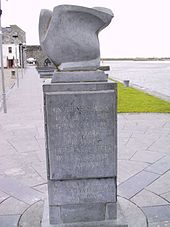 This memorial is a gift from the people of Genoa, Italy, to the people of Galway in commemoration of Columbus's visit. On these shores, around the year 1477, the Genoese sailor Cristoforo Colombo found sure signs of land beyond the Atlantic. La Città di Genova alla Città di Galway. 29.VI.1992.
This memorial is a gift from the people of Genoa, Italy, to the people of Galway in commemoration of Columbus's visit. On these shores, around the year 1477, the Genoese sailor Cristoforo Colombo found sure signs of land beyond the Atlantic. La Città di Genova alla Città di Galway. 29.VI.1992.
Galway City has eleven sister cities. The Galway Committee of Sister Cities International was set up in 1977 with the aim of expanding the City's interaction and to engage in a variety of cultural and governmental exchanges with foreign cities.[45] Galway is twinned with the following places:[46]
City Geographical location Nation Since Aalborg North Jutland  Denmark
Denmark1997 Bradford West Yorkshire, England  United Kingdom
United Kingdom1986 Cambridge[47] Massachusetts  United States of America
United States of America1997 Chicago Illinois  United States of America
United States of America1986 Lorient Brittany  France
France1978 Milwaukee Wisconsin  United States of America
United States of America2001 Moncton New Brunswick  Canada
Canada2002 Qingdao Shandong  China
China1999 St. Louis Missouri  United States of America
United States of America1977 Seattle Washington  United States of America
United States of America1986 Waitakere City Auckland Region  New Zealand
New Zealand2002 Adopted ship
- LÉ Aisling (1996)
See also
- Cities in Ireland
- History of Galway
- Kenny Gallery
- List of abbeys and priories in Ireland (County Galway)
- List of cities, boroughs and towns in the Republic of Ireland
- List of Galway people
- List of RNLI stations
- List of towns and villages in the Republic of Ireland
- Sieges of Galway
References
- ^ "William R. Wilde's Loch Coirib – Its Shores and Islands". Galway.net. http://www.galway.net/galwayguide/history/wrwilde/chapter1/chapter1.html. Retrieved 12 August 2010.
- ^ "Mayor of Galway City". Galway City Council. http://www.galwaycity.ie/AllServices/YourCouncil/MayorofGalwayCity/. Retrieved 6 September 2010.
- ^ After Dublin, Belfast, Cork and Derry. (Limerick city is smaller, as part of the Limerick urban area spills into County Clare).
- ^ a b David B. Quinn "Columbus and the North: England, Iceland, and Ireland", The William and Mary Quarterly, Third Series, Vol 49, No. 2 (Apr., 1992), pp. 278–297
- ^ Kavanagh, Mary. Galway-Gaillimh: a bibliography of the city and county. Galway County Council, 2000.
- ^ a b They were the merchant families of Athy, Blake, Bodkin, Browne, Darcy, Deane, Font, Ffrench, Joyce, Kirwin, Lynch, Martyn, Morris, Skerrett.
- ^ "The Online Historical Population Reports Project www.histpop.org". cso.ie. http://www.cso.ie/census/Census_Pre_1926.htm. Retrieved 12 August 2010.
- ^ [1][dead link]
- ^ "Education Ireland". Educationireland.ie. http://www.educationireland.ie/index.php?option=com_content&task=view&id=185&Itemid=199. Retrieved 12 August 2010.
- ^ a b c "Atlas 2004 – Section 1" (PDF). http://www.galwaycity.ie/AllServices/CityDevelopmentBoard/ProjectsandSchemes/GalwayCityAtlas2004/FileEnglish,671,en.pdf. Retrieved 12 August 2010.
- ^ MSN Travel UK – 2007's Sexiest Cities
- ^ "2008 Travellers' Choice Destination Awards" (PDF). http://cdn.tripadvisor.com/pdfs/tca/TCDestinationsAwards2008.pdf. Retrieved 12 August 2010.
- ^ "Galway Early Music website". Galwayearlymusic.com. 16 March 2000. http://www.galwayearlymusic.com. Retrieved 12 August 2010.
- ^ "Galway Cathedral Recitals website". Recitals.galwaycathedral.ie. http://recitals.galwaycathedral.ie. Retrieved 12 August 2010.
- ^ "World Architecture Images- Ireland- Galway". European-architecture.info. 19 June 2006. http://www.european-architecture.info/EIR/EIR-012.htm. Retrieved 12 August 2010.
- ^ Galwayearlymusic.com
- ^ Galwaysessions.com
- ^ GalwayGardenFestival.com
- ^ Galwayfilmfleadh.com
- ^ Galwaycumunitypride.com
- ^ The first Super 8 picture show, Irish Times, 19 June 2010
- ^ "Hotel Meyrick – About". Greatsouthernhotelgalway.com. http://www.greatsouthernhotelgalway.com/. Retrieved 12 August 2010.
- ^ "About the town hall / its history and more". Tht.ie. http://www.tht.ie/?id=about. Retrieved 12 August 2010.
- ^ "2006 Census results (CSO)" (PDF). http://www.cso.ie/census/documents/census2006_volume_1_pop_classified_by_area.pdf. Retrieved 12 August 2010.
- ^ "RTÉ – 'Census shows drift from big five'". Rte.ie. 26 April 2007. http://www.rte.ie/news/2007/0426/census-business.html. Retrieved 12 August 2010.
- ^ a b Siggins, Lorna (24 September 2009). "Almost 20% of Galway’s citizens are non-Irish". The Irish Times: p. 2. http://www.irishtimes.com/newspaper/ireland/2009/0924/1224255128307.html. Retrieved 8 October 2009.
- ^ "2006 Census results (CSO) – Male/Female Population". Beyond2020.cso.ie. 16 July 2007. http://beyond2020.cso.ie/Census/TableViewer/tableView.aspx?ReportId=76967. Retrieved 12 August 2010.
- ^ "Galway City Development Board – Galway at the Beginning of the 21st century" (PDF). http://www.galwaycity.ie/AllServices/CityDevelopmentBoard/Strategy2002-2012/TheFile,427,en.pdf. Retrieved 12 August 2010.
- ^ 21 February 2007 Investment in Regional Airports to Aid Balanced Regional Development (Department of Community, Rural and Gaeltacht Affairs) "However, before any major development can take place at Galway Airport, the issue of runway length must be addressed. Galway Airport has the second shortest runway length of all of the regional airports in Ireland used for scheduled flights. The total length of the runway is 1350 m, which means that the number of aircraft types that can use it is limited." – Ministerial statement.
- ^ [2][dead link]
- ^ "National and Regional buses to/from Galway". GalwayTransport.info. http://www.galwaytransport.info/2008/12/regional-bus-services-burkes-run-daily.html. Retrieved 12 August 2010.
- ^ http://www.q-park.ie/tabid/425/qparkParkingLocatorvw3443/parkingDetail/ParkingID/1552/language/en-US/Default.aspx
- ^ http://www.gobus.ie
- ^ http://www.citylink.ie
- ^ "Galway station". Railscot – Irish Railways. http://www.railscot.co.uk/Ireland/Irish_railways.pdf. Retrieved 3 September 2007.
- ^ "CIÉ – 'Galway Station Redevelopment'". Cie.ie. http://www.cie.ie/projects/galway_station_redevelopment.asp. Retrieved 12 August 2010.
- ^ "CIÉ – 'Ceannt Station Quarter'". Iarnrodeireann.ie. http://www.iarnrodeireann.ie/news_centre/general_news.asp?action=view&news_id=239. Retrieved 12 August 2010.
- ^ "Galway City Outer Bypass – Map" (PDF). http://www.galwaycity.ie/AllServices/Planning/Publications/FileEnglish,3522,en.pdf. Retrieved 12 August 2010.
- ^ "Galway City Council – Galway City Outer Bypass". Galwaycity.ie. http://www.galwaycity.ie/AllServices/RoadsandTraffic/StudiesandSchemes/ProposedN6GalwayCityOuterBypass/. Retrieved 12 August 2010.
- ^ "Waterways of Galway; – Galway Guide". Galway.net. http://www.galway.net/galwayguide/history/waterways/. Retrieved 12 August 2010.
- ^ Green Party – Transport[dead link]
- ^ "Microsoft Word - Atlas 2004 Section1.doc" (PDF). http://www.galwaycity.ie/AllServices/CityDevelopmentBoard/ProjectsandSchemes/GalwayCityAtlas2004/FileEnglish,665,en.pdf. Retrieved 12 August 2010.
- ^ Basketballireland.ie
- ^ "Titans Basketball Club – About the club". Titans.ie. http://www.titans.ie/index.php?option=com_content&view=article&id=54. Retrieved 12 August 2010.
- ^ "Committee of Sister Cities International". Chicago Sister Cities. http://www.chicagosistercities.com/cities/galway.php. Retrieved 21 July 2011.
- ^ "Galway City Council – Town Twinnings". Galwaycity.ie. http://www.galwaycity.ie/AllServices/YourCouncil/TownTwinings/. Retrieved 12 August 2010.
- ^ "A Message from the Peace Commission: Information on Cambridge's Sister Cities," 15 February 2008. Retrieved 12 October 2008.
External links
- Galway Chamber of Commerce and Industry
- Galway City Council (local authority)
- Polish website about Galway
- Galway travel guide from Wikitravel
- Virtual Tour of Galway
- Moving Postcards of Galway
Cities in Ireland Republic of Ireland Northern Ireland - not an administrative city
Counties of Ireland The counties are listed per provinceConnacht Munster Leinster Ulster Italics denote non-administrative counties. Brackets denote eponymous cities or non-traditional counties. † denotes counties of Northern IrelandCategories:- Cities in the Republic of Ireland
- Galway (city)
- Port cities and towns in the Republic of Ireland
- University towns
- County towns in the Republic of Ireland
- Connacht
- Local administrative units of the Republic of Ireland
Wikimedia Foundation. 2010.



